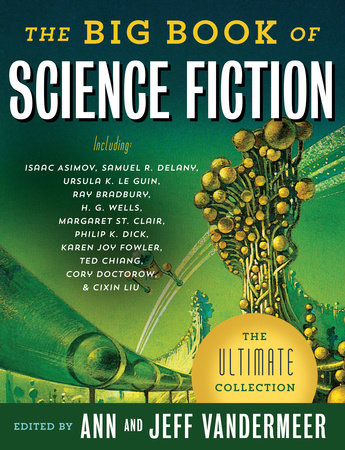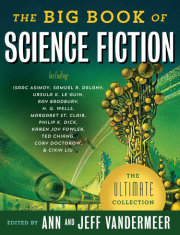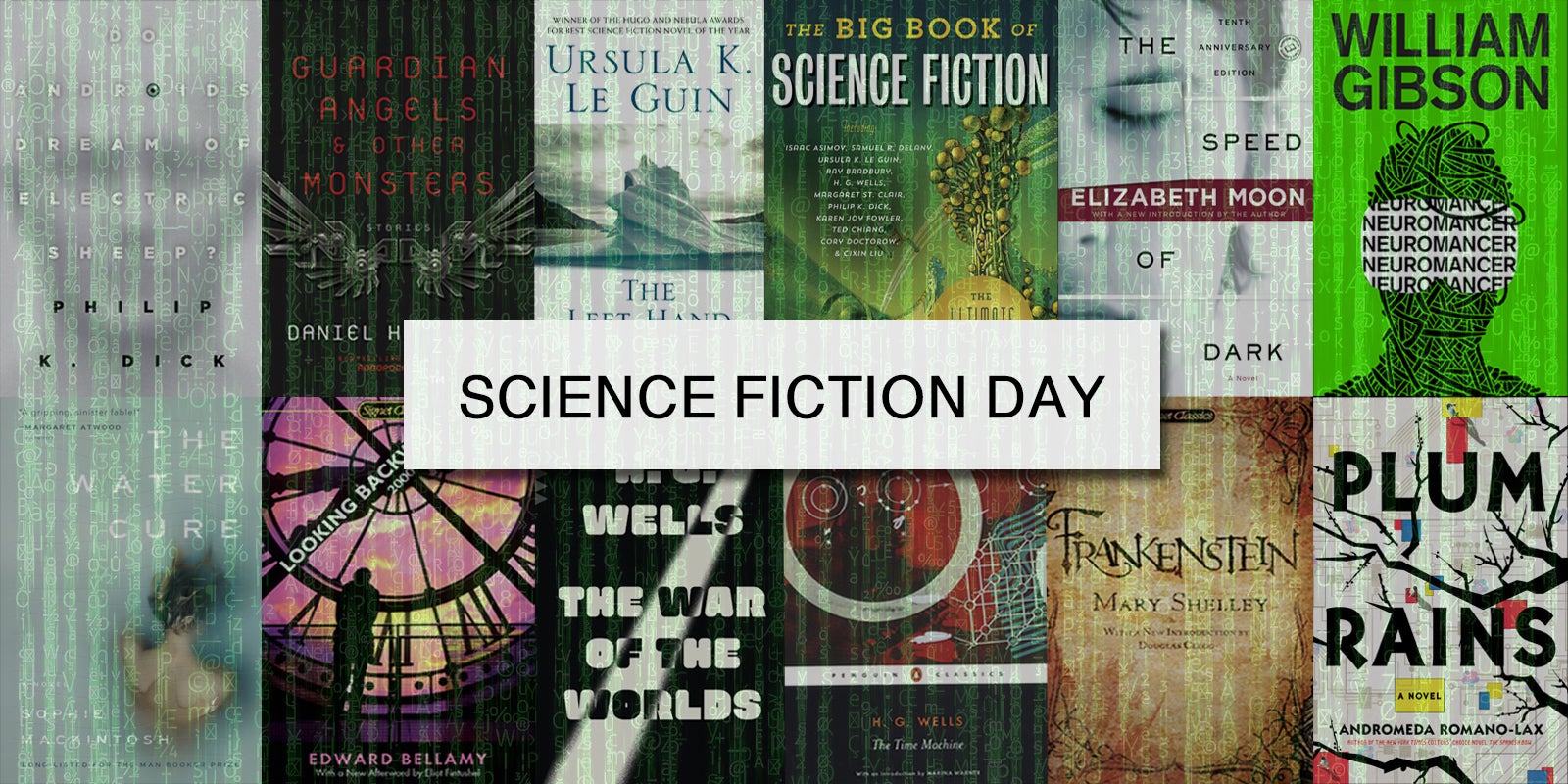From the Introduction Since the days of Mary Shelley, Jules Verne, and H. G. Wells, science fiction has not just helped define and shape the course of literature but reached well beyond fictional realms to influence our perspectives on culture, science, and technology. Ideas like electric cars, space travel, and forms of advanced communication comparable to today’s cell phone all first found their way into the public’s awareness through science fiction. In stories like Alicia Yánez Cossío’s “The IWM 100” from the 1970s you can even find a clear prediction of Information Age giants like Google—and when Neil Armstrong set foot on the moon, the event was a very real culmination of a yearning already expressed through science fiction for many decades.
Science fiction has allowed us to dream of a better world by creating visions of future societies without prejudice or war. Dystopias, too, like Ray Bradbury’s
Fahrenheit 451, have had their place in science fiction, allowing writers to comment on injustice and dangers to democracy. Where would Eastern Bloc writers have been without the creative outlet of science fiction, which by seeming not to speak about the present day often made it past the censors? For many under Soviet domination during those decades, science fiction was a form of subversion and a symbol of freedom. Today, science fiction continues to ask “What if?” about such important topics as global warming, energy dependence, the toxic effects of capitalism, and the uses of our modern technology, while also bringing back to readers strange and wonderful visions.
No other form of literature has been so relevant to our present yet been so filled with visionary and transcendent moments. No other form has been as entertaining, either. But until now there has been no definitive and complete collection that truly captured the global influence and significance of this dynamic genre—bringing together authors from all over the world and from both the “genre” and “literary” ends of the fiction spectrum.
The Big Book of Science Fiction covers the entire twentieth century, presenting, in chronological order, stories from more than thirty countries, from the pulp space opera of Edmond Hamilton to the literary speculations of Jorge Luis Borges, from the pre-Afrofuturism of W. E. B. Du Bois to the second-wave feminism of James Tiptree Jr.—and beyond!
What you find within these pages may surprise you. It definitely surprised us.
WHAT IS THE “GOLDEN AGE” OF SCIENCE FICTION?
Even people who do not read science fiction have likely heard the term “the Golden Age of Science Fiction.” The actual Golden Age of Science Fiction lasted from about the mid-1930s to the mid-1940s, and is often conflated for general readers with the preceding Age of the Pulps (1920s to mid-1930s). The Age of the Pulps had been dominated by the editor of
Amazing Stories, Hugo Gernsback. Sometimes called the Father of Science Fiction, Gernsback was most famously photographed in an all-encompassing “Isolator” author helmet, attached to an oxygen tank and breathing apparatus.
The Golden Age dispensed with the Isolator, coinciding as it did with the proliferation of American science fiction magazines, the rise of the ultimately divisive editor John W. Campbell at
Astounding Science Fiction (such strict definitions and such a dupe for
Dianetics!), and a proto-market for science fiction novels (which would only reach fruition in the 1950s). This period also saw the rise to dominance of authors like Isaac Asimov, Arthur C. Clarke, Poul Anderson, C. L. Moore, Robert Heinlein, and Alfred Bester. It fixed science fiction in the public imagination as having a “sense of wonder” and a “can-do” attitude about science and the universe, sometimes based more on the earnest, naïve covers than the actual content, which could be dark and complex.
But “the Golden Age” has come to mean something else as well. In his classic, oft-quoted book on science fiction,
Age of Wonders: Exploring the World of Science Fiction (1984), the iconic anthologist and editor David Hartwell asserted that “the Golden Age of Science Fiction is 12.” Hartwell, an influential gatekeeper in the field, was making a point about the arguments that “rage until the small of the morning” at science fiction conventions among “grown men and women” about that time when “every story in every magazine was a master work of daring, original thought.” The reason readers argue about whether the Golden Age occurred in the 1930s, 1950s, or 1970s, according to Hartwell, is because the true age of science fiction is the age at which the reader has no ability to tell good fiction from bad fiction, the excellent from the terrible, but instead absorbs and appreciates just the wonderful visions and exciting plots of the stories.
This is a strange assertion to make, one that seems to want to make excuses. It’s often repeated without much analysis of how such a brilliant anthology editor also credited with bringing literary heavyweights like Gene Wolfe and Philip K. Dick to readers would want to (inadvertently?) apologize for science fiction while at the same time engaging in a sentimentality that seems at odds with the whole enterprise of truly speculative fiction. (Not to mention dissing twelve-year-olds!)
Perhaps one reason for Hartwell’s stance can be found in how science fiction in the United States, and to some extent in the United Kingdom, rose out of pulp magazine delivery systems seen as “low art.” A pronounced “cultural cringe” within science fiction often combines with the brutal truth that misfortunes of origin often plague literature, which can assign value based on how swanky a house looks from the outside rather than what’s inside. The new Kafka who next arises from cosmopolitan Prague is likely to be hailed a savior, but not so much the one who arises from, say, Crawfordville, Florida.
There is also something of a need to apologize for the ma-and-pop tradition exemplified by the pulps, with their amateurish and eccentric editors, who sometimes had little formal training and possessed as many eccentricities as freckles, and who came to dominate the American science fiction world early on. Sometimes an Isolator was the least of it.
Yet even with regard to the pulps, evidence suggests that these magazines at times entertained more sophisticated content than generally given credit for, so that in a sense an idea like “the Golden Age of Science Fiction is 12” undermines the truth about such publications. It also renders invisible all of the complex science fiction being written outside of the pulp tradition.
Therefore, we humbly offer the assertion that contrary to popular belief and based on all of the evidence available to us . . . the actual Golden Age of Science Fiction is twenty-one, not twelve. The proof can be found in the contents of this anthology, where we have, as much as possible, looked at the totality of what we think of “science fiction,” without privileging the dominant mode, but also without discarding it. That which may seem overbearing or all of a type at first glance reveals its individuality and uniqueness when placed in a wider context. At third or fourth glance, you may even find that stories from completely different traditions have commonalities and speak to each other in interesting ways.
BUILDING A BETTER DEFINITION OF “SCIENCE FICTION”
We evoked the names of Mary Shelley, Jules Verne, and H. G. Wells at the beginning of this introduction for a very specific reason. All three are useful entry points or origin points for science fiction because they do not exist so far back in time as to make direct influence seem ethereal or attenuated, they are still known in the modern era, and because the issues they dealt with permeate what we call the “genre” of science fiction even today.
We hesitate to invoke the slippery and preternatural word
influence, because influence appears and disappears and reappears, sidles in and has many mysterious ways. It can be as simple yet profound as reading a text as a child and forgetting it, only to have it well up from the subconscious years later, or it can be a clear and all-consuming passion. At best we can only say that someone cannot be influenced by something not yet written or, in some cases, not yet translated. Or that influence may occur not when a work is published but when the writer enters the popular imagination—for example, as Wells did through Orson Welles’s infamous radio broadcast of
War of the Worlds (1938) or, to be silly for a second, Mary Shelley through the movie
Young Frankenstein (1974).
For this reason even wider claims of influence on science fiction, like writer and editor Lester del Rey’s assertion that the Mesopotamian
Epic of Gilgamesh is the earliest written science fiction story, seem appropriative, beside the point, and an overreach for legitimacy more useful as a “tell” about the position of science fiction in the 1940s and 1950s in North America.
But we brought up our triumvirate because they represent different strands of science fiction. The earliest of these authors, Mary Shelley, and her
Frankenstein (1818), ushered in a modern sensibility of ambivalence about the uses of technology and science while wedding the speculative to the horrific in a way reflected very early on in science fiction. The “mad scientist” trope runs rife through the pages of the science fiction pulps and even today in their modern equivalents. She also is an important figure for feminist SF.
Jules Verne, meanwhile, opened up lines of inquiry along more optimistic and hopeful lines. For all that Verne liked to create schematics and specific detail about his inventions—like the submarine in
Twenty Thousand Leagues Under the Sea (1870)—he was a very happy puppy who used his talents in the service of scientific romanticism, not “hard science fiction.”
H. G. Wells’s fiction was also dubbed “scientific romanticism” during his lifetime, but his work existed somewhere between these two foci. His most useful trait as the godfather of modern science fiction is the granularity of his writing. Because his view of the world existed at an intersection of sociology, politics, and technology, Wells was able to create complex geopolitical and social contexts for his fiction—indeed, after he abandoned science fiction, Wells’s later novels were those of a social realist, dealing with societal injustice, among other topics. He was able to quantify and fully realize extrapolations about the future and explore the iniquities of modern industrialization in his fiction.
The impulse to directly react to how industrialization has affected our lives occurs very early on in science fiction—for example, in Karl Hans Strobl’s cautionary factory tale “The Triumph of Mechanics” (1907) and even in the playful utopian visions of Paul Scheerbart, which often pushed back against bad elements of “modernization.” (For his optimism, Scheerbart perished in World War I, while Strobl’s “reward” was to fall for fascism and join the Nazi Party—in part, a kind of repudiation of the views expressed in “The Triumph . . .”)
Social and political issues also peer out from science fiction from the start, and not just in Wells’s work. Rokheya Shekhawat Hossein’s “Sultana’s Dream” (1905) is a potent feminist utopian vision. W. E. B. Du Bois’s “The Comet” (1920) isn’t just a story about an impending science-fictional catastrophe but also the start of a conversation about race relations and a proto-Afrofuturist tale. The previously untranslated Yefim Zozulya’s “The Doom of Principal City” (1918) presages the atrocities perpetrated by the communism of the Soviet Union and highlights the underlying absurdities of certain ideological positions. (It’s perhaps telling that these early examples do not come from the American pulp SF tradition.)
This kind of eclectic stance also suggests a simple yet effective definition for science fiction:
it depicts the future, whether in a stylized or realistic manner. There is no other definitional barrier to identifying science fiction unless you are intent on defending some particular territory. Science fiction
lives in the future, whether that future exists ten seconds from the Now or whether in a story someone builds a time machine a century from now in order to travel back into the past. It is science fiction whether the future is phantasmagorical and surreal or nailed down using the rivets and technical jargon of “hard science fiction.” A story is also science fiction whether the story in question is, in fact, extrapolation about the future or using the future to comment on the past or present.
Thinking about science fiction in this way delinks the actual content or “experience” delivered by science fiction from the commodification of that genre by the marketplace. It does not privilege the dominant mode that originated with the pulps over other forms. But neither does it privilege those other manifestations over the dominant mode. Further, this definition eliminates or bypasses the idea of a “turf war” between genre and the mainstream, between commercial and literary, and invalidates the (weird ignorant snobbery of) tribalism that occurs on one side of the divide and the faux snobbery (ironically based on ignorance) that sometimes manifests on the other.
Wrote the brilliant editor Judith Merril in the seventh annual edition of
The Year’s Best S-F (1963), out of frustration:
“But that’s not science fiction . . . !” Even my best friends (to invert a paraphrase) keep telling me: That’s not science fiction! Sometimes they mean it couldn’t be s-f, because it’s good. Sometimes it couldn’t be because it’s not about spaceships or time machines. (Religion or politics or psychology isn’t science fiction—is it?) Sometimes (because some of my best friends are s-f fans) they mean it’s not really science fiction—just fantasy or satire or something like that.
On the whole, I think I am very patient. I generally manage to explain again, just a little wearily, what the “S-F” in the title of this book means, and what science fiction is, and why the one contains the other, without being constrained by it. But it does strain my patience when the exclamation is compounded to mean, “Surely you don’t mean to use that? That’s not science fiction!”—about a first-rate piece of the honest thing.
Standing on either side of this debate is corrosive—detrimental to the study and celebration of science fiction; all it does is sidetrack discussion or analysis, which devolves into SF/not SF or intrinsically valuable/not valuable. And, for the general reader weary of anthologies prefaced by a series of “inside baseball” remarks, our definition hopefully lessens your future burden of reading these words.
Copyright © 2016 by Jeff Vandermeer. All rights reserved. No part of this excerpt may be reproduced or reprinted without permission in writing from the publisher.



